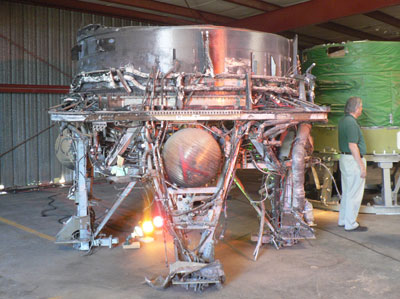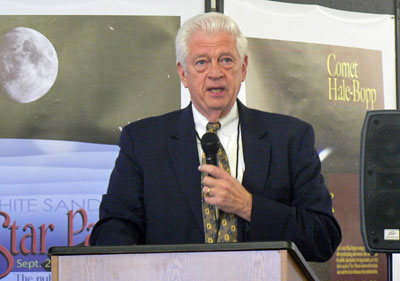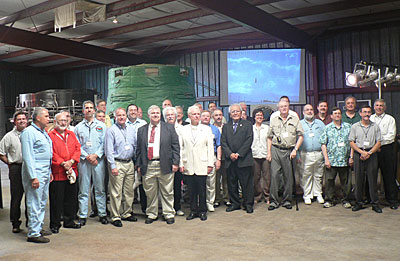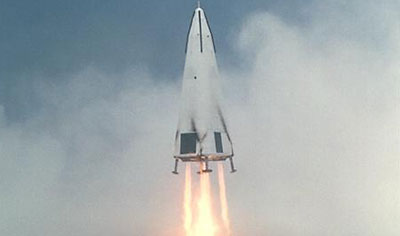The legacy of DC-Xby Jeff Foust
|
| The conference had an atmosphere of pride and poignancy: pride in what had been accomplished by the team, often against long odds; poignancy in that the DC-X was less a first step than a false start on the path to low-cost access to space. |
For a few years in the early and mid 1990s, the DC-X offered a bright new future for space transportation: a demonstration of how a low-cost reusable launch vehicle (RLV) might operate. The DC-X never flew to space, nor was it designed to (it never flew higher than about three kilometers) yet the vehicle, developed by a small team at McDonnell Douglas under a modest budget, attracted the interest of a wide cross-section of people, from the Defense Department to space activists, who saw the DC-X as the first step towards a true RLV.
Many of the people involved in DC-X, from project leaders to the engineers and technicians who worked on the vehicle to those who supported the project in one way or another, gathered in Alamogordo last week for a three-day conference in recognition of the 15th anniversary of the first DC-X flight on August 18, 1993. As attendees looked back on the program, the conference had an atmosphere of pride and poignancy: pride in what had been accomplished by the team, often against long odds; poignancy in that the DC-X was less a first step than a false start on the path to low-cost access to space.
 Artifacts from the DC-X program in storage in Alamogordo, New Mexico. (credit: J. Foust) |
“The opportunity to make history”
The history of the DC-X program is fairly well known, and typically starts with a 1989 meeting between vice president Dan Quayle and a trio of advocates for the program: retired general Daniel Graham, aerospace engineer Max Hunter, and science fiction author and space activist Jerry Pournelle. The three were able to convince Quayle of the importance and technical feasibility of a single stage to orbit (SSTO) RLV and get him to support a technology demonstrator that would become DC-X.
Pournelle, the surviving member of that trio who met with Quayle, recalled that the vice president asked Hunter as the meeting was ending why something like this wasn’t done 20 years ago: were there technological developments that now made it possible? “And Max said, ‘No, sir, we just weren’t smart enough,’” Pournelle recalled. “I have a suspicion that may have been the convincing argument, that the premier rocket scientist in the country would admit that we just weren’t smart enough.”
Ostensibly, DC-X was assigned to the Strategic Defense Initiative Organization (SDIO) because a space-based missile defense system would need the kind of frequent, cost-effective space access promised by RLVs. Putting it there also kept it away from the bureaucracies of NASA and the Air Force, neither of which may have been inclined to support it as much as SDIO. “The concern was that it would have been out of step with Shuttle and Shuttle replacement at NASA, and it might not be a popular alternative to expendable launch at the Air Force,” recalled Ambassador Henry Cooper, the director of SDIO for much of the development of DC-X.
Cooper was not involved with the beginning of DC-X but helped shepherd the program during its development. “My contribution, if any, was keeping the bureaucracy off the back of the small team” that worked on the project, he said. That involved creating a “defensible strategy” within the Pentagon bureaucracy, an effort that included winning over the comptroller of the Defense Department, Cooper recalled—a man by the name of Sean O’Keefe, who would later become administrator of NASA.
While Cooper was providing bureaucratic cover in Washington, a small team in California, and later New Mexico, was building the DC-X and preparing it for its test flights at White Sands under the leadership of former astronaut Pete Conrad. Members of the DC-X at the conference universally spoke warmly about Conrad, who died in a motorcycle accident in 1999, sharing anecdotes about his no-nonsense, upbeat managing style.
| “My contribution, if any, was keeping the bureaucracy off the back of the small team” that worked on the project, Cooper said. |
A key incident that many people recalled during the conference was the storm that hit White Sands the night before the scheduled first flight, damaging equipment and flooding the launch site. “Arriving at the pad at around 4:30 in the morning and seeing the damage was appalling,” recalled Joaquin Castro, who was on the DC-X propulsion team. “A pall of failure hung over the team as we surveyed the damage… there was no way we were going to fly that day.”
Conrad, though, was undaunted, Castro recalled. “He looked at all of us, got us in a huddle, and said, ‘We have the opportunity to make history here today. We have a whole bunch of people coming to see us fly this afternoon. It will not be easy, but if anybody can do it, it’s us. Let’s not give up without trying.’” Conrad then picked up a shovel, Castro said, and started cleaning out one of the trenches at the site that has been filled with sand and water by the storm. “The rest is history.”
 Ambassador Henry Cooper speaks about the early history of DC-X at the Alamogordo conference. (credit: J. Foust) |
No longer under the radar
The first flight of the DC-X may have been the high point of the program. Prior to that flight the DC-X was a small, obscure program not widely known outside of a few government offices and some parts of the space advocacy community. Once the DC-X flew, and attracted some media attention, its profile became a lot higher.
“I think at the time no one thought you could make revolutionary space capabilities for $60 million, so it was under the radar horizon,” said Henry Vanderbilt, a space advocate and founder of the Space Access Society. “One of the reasons I think we haven’t seen an effective follow-on to DC-X in the 15 years since is because you guys were good enough that you very effectively caused the radar to be angled a lot closer to the horizon.”
Complicating matters was a change in presidential administrations that transformed the SDIO, including changing its name to the Ballistic Missile Defense Organization (BMDO). “Regrettably, though, the program was not politically correct,” lamented Cooper, who blamed the “anti-militarization of space crowd” for cutting funding for DC-X and a host of other technology development programs in the former SDIO.
DC-X did hang on, though, for nearly three more years after that first flight, first within BMDO and later in NASA as the DC-XA, but not without considerable struggles for money. “It was the Perils of Pauline for three years,” said Tim Kyger, a Congressional staffer and DC-X advocate at the time. “It burned me out, for all practical purposes.”
| “One of the reasons I think we haven’t seen an effective follow-on to DC-X in the 15 years since is because you guys were good enough that you very effectively caused the radar to be angled a lot closer to the horizon,” Vanderbilt told attendees. |
DC-X was supposed to lead to a larger prototype, DC-Y, that would perform suborbital and eventually orbital flights. “If we had another four years, we could have at least gotten to the suborbital stage, and I could have shown the benefits of the program” particularly as a means of deploying targets for missile defense tests, said Cooper. “Then we would have been on a viable path to wherever we wanted to go.”
What instead happened is that NASA took over development of RLV technology and started the X-33 program. And, much to the disdain of the DC-X team, NASA selected a Lockheed Martin design over a DC-X-derived design submitted by McDonnell Douglas. The X-33, of course, never flew, and was quietly cancelled in 2001.
“The purpose of X-33 was to demonstrate that you need expendables, and by golly, it did that,” quipped Pournelle.
 Members of the DC-x team gather in front of the project's remaining hardware for a group portrait at the DC-X reunion conference in Alamogordo. Behind them to the right is a video of the DC-X’s first flight 15 years ago. (credit: J. Foust) |
Legacy
On the surface, the DC-X was a dead end: rather than being the first step towards the development of an SSTO RLV, it was bypassed in favor of other programs, like the X-33 and X-34, that also failed to make headway towards the Holy Grail of low-cost space access. That goal seems nearly as distant today as it did 15 years ago.
Some involved with the project, though, take a more positive view. “Was it all for naught? I don’t think so,” said Jess Sponable, a former DC-X program manager. DC-X sparked a resurgence in experimental “X-vehicles” both in the Air Force and NASA, he said. “Yes, we had some failures” in some of those X-programs, he said, “but we learned as much from those failures as we did from the successes.”
Another thing DC-X did, he said, was jumpstart the development of commercial vehicles. There was an initial generation of vehicles and ventures that “captured the vision of DC-X in different ways” in the 1990s, during the telecom boom that promised a market for hundreds, of not thousands, of low Earth orbit satellites. More recently, a second generation inspired by DC-X has emerged, focused primarily, although not exclusively, on suborbital spaceflight. Not only are some of these ventures using the same vertical takeoff, vertical landing approach used by DC-X, they’ve hired some of the people who worked on the DC-X.
In fact, roughly the same flight profile that was flown by the DC-X on its first flight is the basis for the Lunar Lander Challenge, run by the X Prize Foundation with prize money provided by NASA’s Centennial Challenges program. What once required the resources of a government program and a team of major aerospace firms is now being attempted, with varying degrees of success to date, by small entrepreneurial companies and even hobbyist teams.
| “Was it all for naught? I don’t think so,” said Sponable. |
Given that record, what if the government tried to capture that magic again? How would it do an RLV technology development program like DC-X? Cooper doesn’t think his former agency, now known as the Missile Defense Agency (MDA), would be the best place for it. “I’m not sure exactly where I’d put it, but I wouldn’t put it inside the Missile Defense Agency,” he said. “The Missile Defense Agency has become too large and too bureaucratic.” DARPA, he said, would be a better alternative to either the Air Force or NASA.
Kyger said the ideal situation would be to create a “super SDIO” that reported directly to the president with adequate funding and contractual authority. The problem with that, he said, is that if a future president thought cheap access to space was a priority, “he’s going to give it to NASA. Why wouldn’t he? It’s the space agency, isn’t it?”
Even if that magic can’t be recaptured, it’s clear that DC-X has a major influence on the field of space access, as well as the people who were involved in the program. It even got NASA administrator Mike Griffin, who was deputy for technology at SDIO when the DC-X program started, to wax poetic—literally—in a luncheon speech at the conference. He recited the Saint Crispin’s Day speech from Shakespeare’s Henry V, where the king roused his troops on the morning of the Battle of Agincourt by telling them how they would remember their deeds that day for the rest of their lives.
“Following the logic of Henry V, many of you in this room are my brothers, and we’ve earned some scar tissue together. We display it today with some measure of pride and fond memories, not only for our esprit de corps, but for having accomplished something new, worthwhile, and, we hope, long-lasting,” Griffin said. DC-X was certainly new, and most would argue worthwhile. How long lasting its influence is will depend on its ability to inspire the generations of ventures that have continued the quest to revolutionize access to space.
